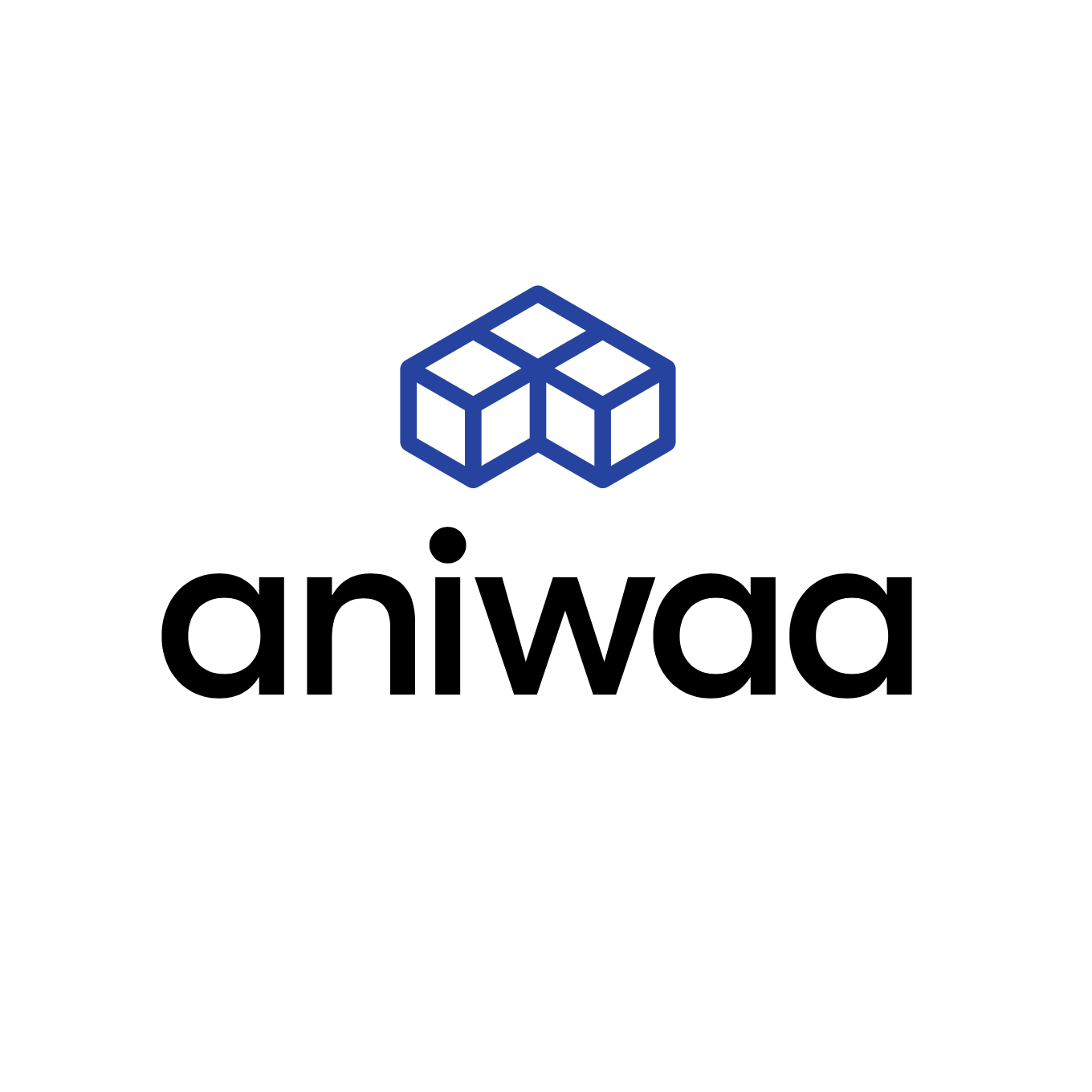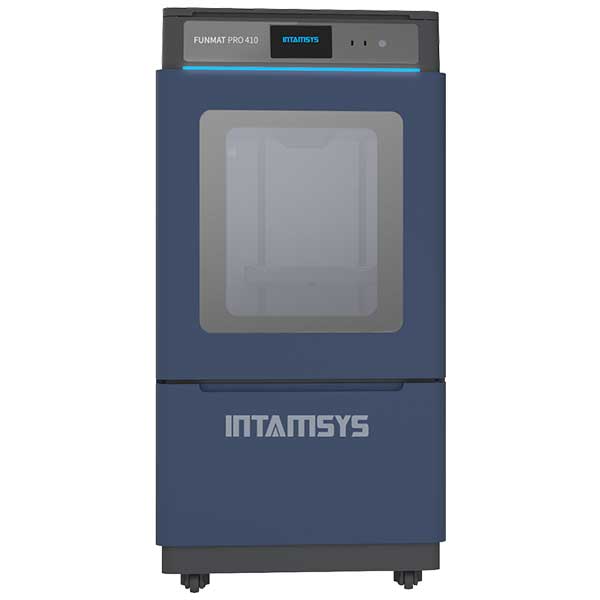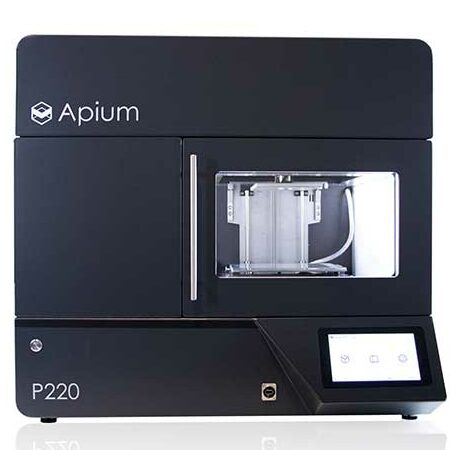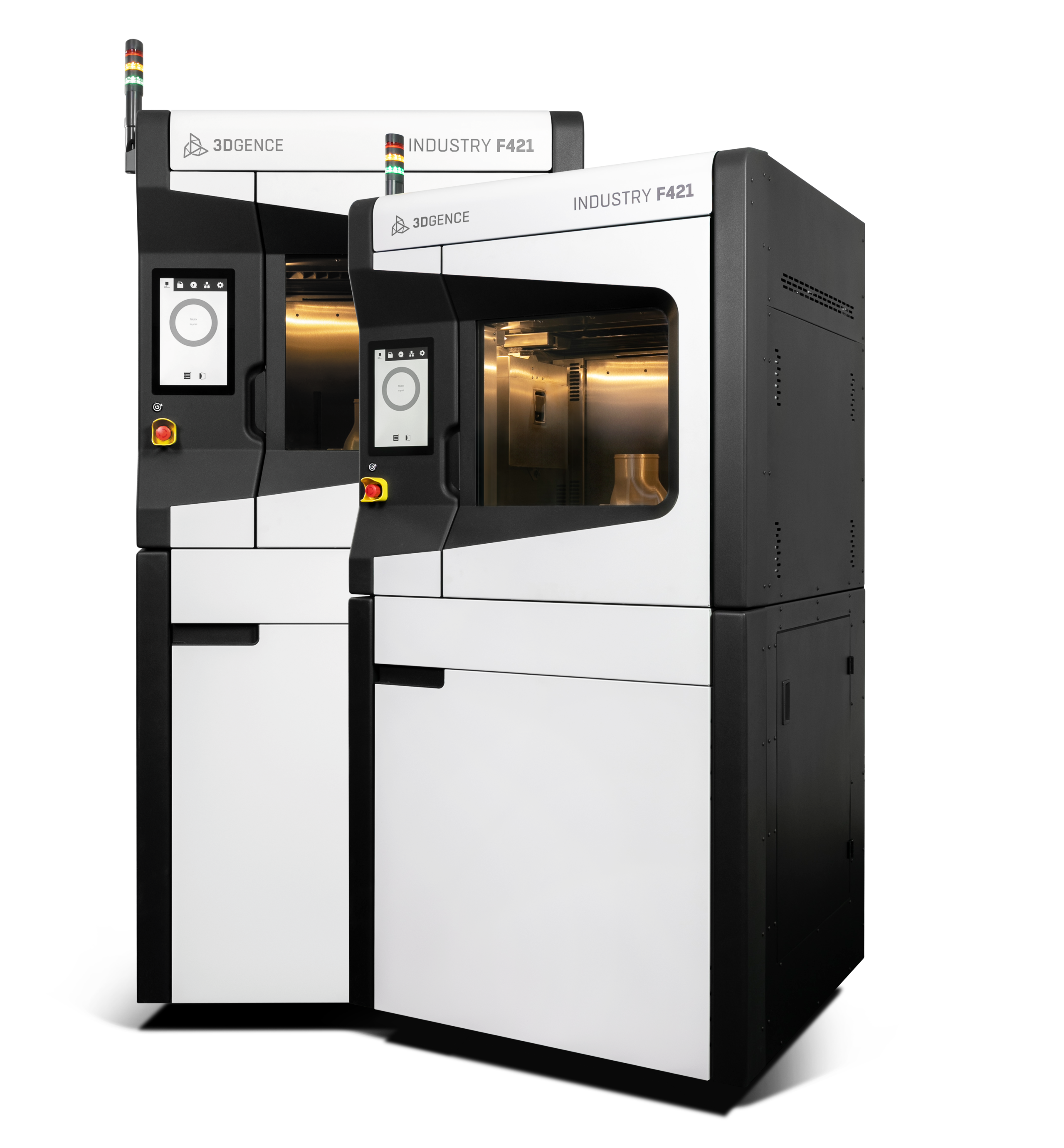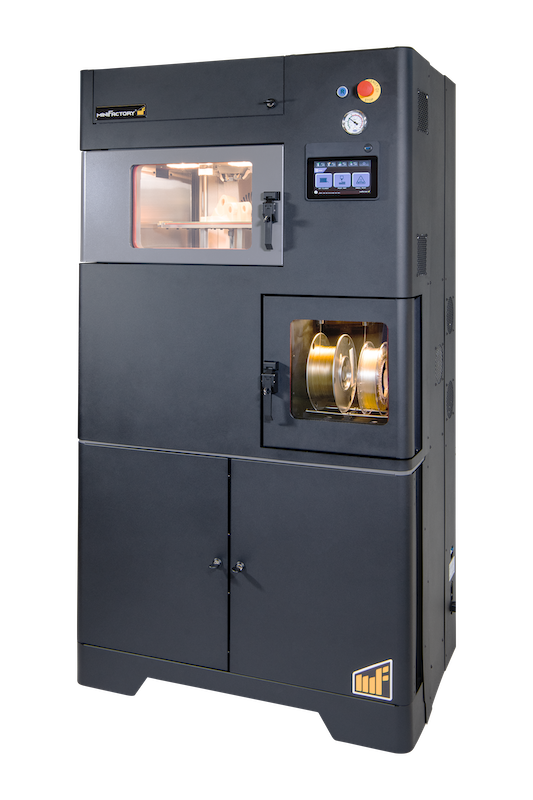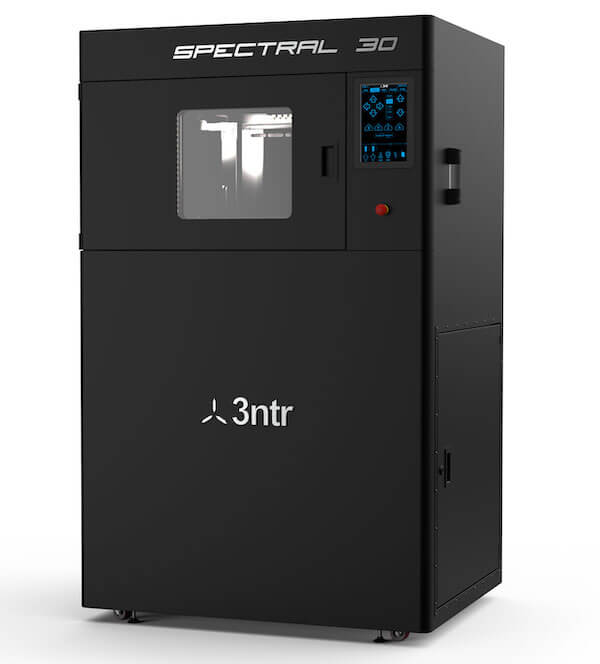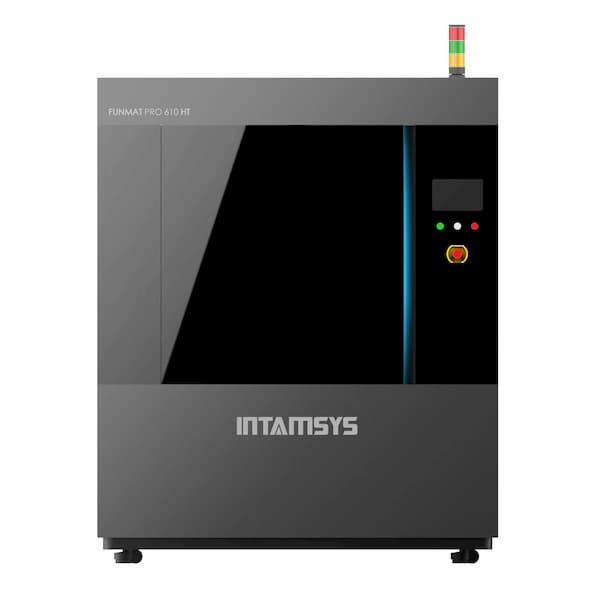PEEK 3D printer 2024: high-temperature 3D printers for high-performance polymers

Introduction
PEEK, like PEI (ULTEM) and PEKK, is a high-performance polymer (a.k.a. “ultra polymer” and sometimes “super polymer”) that is able to maintain its mechanical properties in challenging environments. Its continuous use temperature (CUT) can go over 250°C, and it is resistant to almost all chemicals except for nitric and sulphuric acids. For decades, this high-performance thermoplastic has been used in demanding industries such as aerospace, oil and gas, and more.
The 3D printing of high-performance polymers like PEEK is, however, a challenge. It requires a high-temperature extruder and a heated chamber – among other tightly monitored elements – above and beyond what standard FFF 3D printers offer. And whereas the PEEK 3D printer market used to be a niche with very few players, today, many manufacturers claim that their printers are suitable for PEEK and PEI 3D printing. Aniwaa’s 3D printer catalog lists over 90 high-temperature 3D printers!
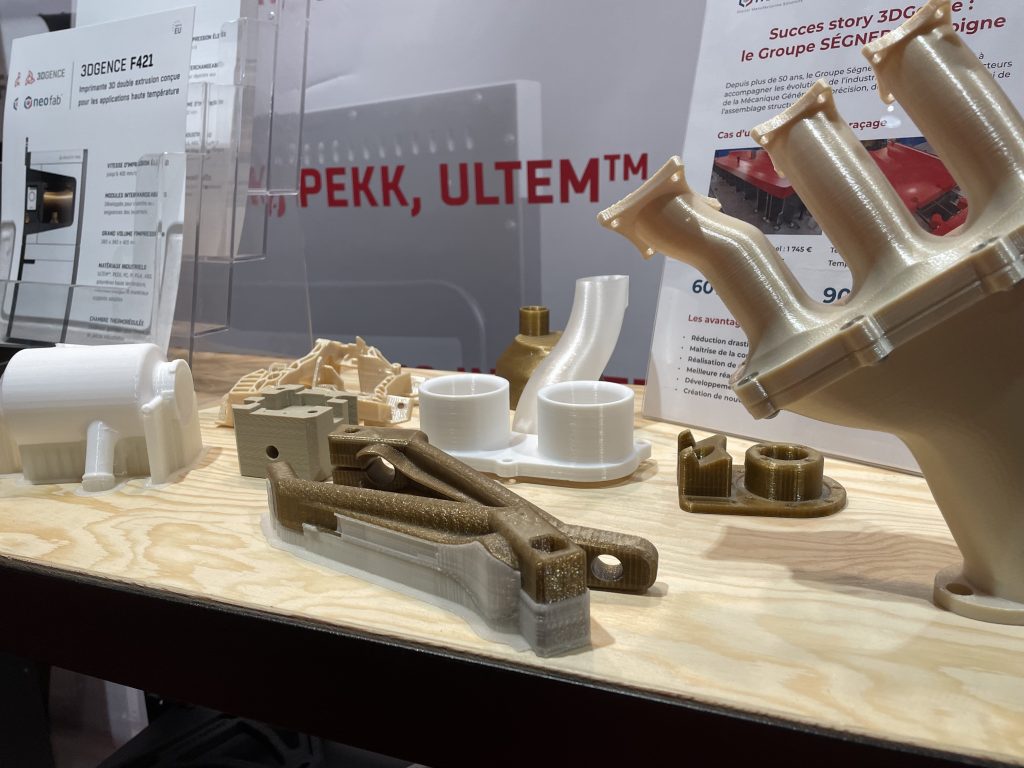
But boasting high-temperature extruders and heated chambers is often not enough. Thus, our goal here is to select high-temperature 3D printers that stand out from the rest, and not only in terms of hardware. We also take into account a range of factors such as manufacturer maturity, feedback from our network, availability, and distribution.
Of course, this doesn’t mean they’re the only ones out there, but they are some of the most reliable solutions for high-performance polymer AM (additive manufacturing). We mention a few cost-effective options and industry-specific machines in separate sections so as to provide a comprehensive overview nonetheless.
We work with a large number of distributors and brands worldwide– contact us for a personalized recommendation based on your project and location.
High-temperature 3D printers 2024: our selection
The table below recaps our selection of some of the best PEEK 3D printer options. The goal is to provide a quick, visual overview of the market; there are of course numerous other factors to take into account (certifications, software, customer service, …) to get the full picture for each solution and eventually make the right choice.
| Brand | Product | Build size | Country | Price
Approximate starting prices based on supplier-provided information and public data. Prices may vary by region, over time and do not include additional products or services (taxes, shipping, accessories, training, installation, …).
| |
|---|---|---|---|---|---|
| INTAMSYS
Product data validated by the manufacturer.
| FUNMAT PRO 410 | 305 × 305 × 406 mm | China | $ 23,000 | Quote |
| Apium | P220 | 205 × 155 × 150 mm | Germany | $ 29,000 | Quote |
| 3DGence
This manufacturer is a Verified partner from our network.
| INDUSTRY F421 | 380 × 380 × 420 mm | Poland | $ 50,000 | Quote |
| miniFactory
Product data validated by the manufacturer.
| Ultra | 330 × 180 × 180 mm | Finland | $ 65,000 | Quote |
| 3ntr
Product data validated by the manufacturer.
| Spectral 30 | 300 × 300 × 300 mm | Italy | $ 110,000 | Quote |
| INTAMSYS
Product data validated by the manufacturer.
| FUNMAT PRO 610HT | 610 × 508 × 508 mm | China | upon request | Quote |
| Roboze
Product data validated by the manufacturer.
| ARGO 500 | 500 × 500 × 500 mm | Italy | upon request | Quote |
| Stratasys
Product data validated by the manufacturer.
| Fortus 450mc | 406 × 355 × 406 mm | United States | upon request | Quote |
Note: There are over 90 printers that are supposedly capable of 3D printing PEEK and other high-performance materials. This is a shortlist of what we believe to be some of the best PEEK 3D printers on the market.
The products in the table are ranked by price (low to high).

| Brand | Product | Build size | Build volume | Extruder temp. | Build plate temp. | Build chamber temp. | Country | Price
Approximate starting prices based on supplier-provided information and public data. Prices may vary by region, over time and do not include additional products or services (taxes, shipping, accessories, training, installation, …).
| |
|---|---|---|---|---|---|---|---|---|---|
| INTAMSYS
Product data validated by the manufacturer.
| FUNMAT PRO 410 | 305 × 305 × 406 mm | 37.77 L | – | – | 90°C | China | $ 23,000 | Get a quote |
| Apium | P220 | 205 × 155 × 150 mm | 4.77 L | – | – | 180°C | Germany | $ 29,000 | Get a quote |
| 3DGence
This manufacturer is a Verified partner from our network.
| INDUSTRY F421 | 380 × 380 × 420 mm | 60.65 L | – | – | 195°C | Poland | $ 50,000 | Get a quote |
| miniFactory
Product data validated by the manufacturer.
| Ultra | 330 × 180 × 180 mm | 10.69 L | – | – | 250°C | Finland | $ 65,000 | Get a quote |
| 3ntr
Product data validated by the manufacturer.
| Spectral 30 | 300 × 300 × 300 mm | 27 L | – | – | 250°C | Italy | $ 110,000 | Get a quote |
| INTAMSYS
Product data validated by the manufacturer.
| FUNMAT PRO 610HT | 610 × 508 × 508 mm | 157.42 L | – | – | 300°C | China | upon request | Get a quote |
| Roboze
Product data validated by the manufacturer.
| ARGO 500 | 500 × 500 × 500 mm | 125 L | – | – | 180°C | Italy | upon request | Get a quote |
| Stratasys
Product data validated by the manufacturer.
| Fortus 450mc | 406 × 355 × 406 mm | 58.52 L | – | 350°C | 350°C | United States | upon request | Get a quote |
Below, we mapped these PEEK 3D printers by price and chamber temperature. Again, there are other factors to take into account (manufacturer maturity, customer service, warranties, material choice, certifications, etc.) – this is just a preliminary, simplistic view of the high-temperature 3D printer market.
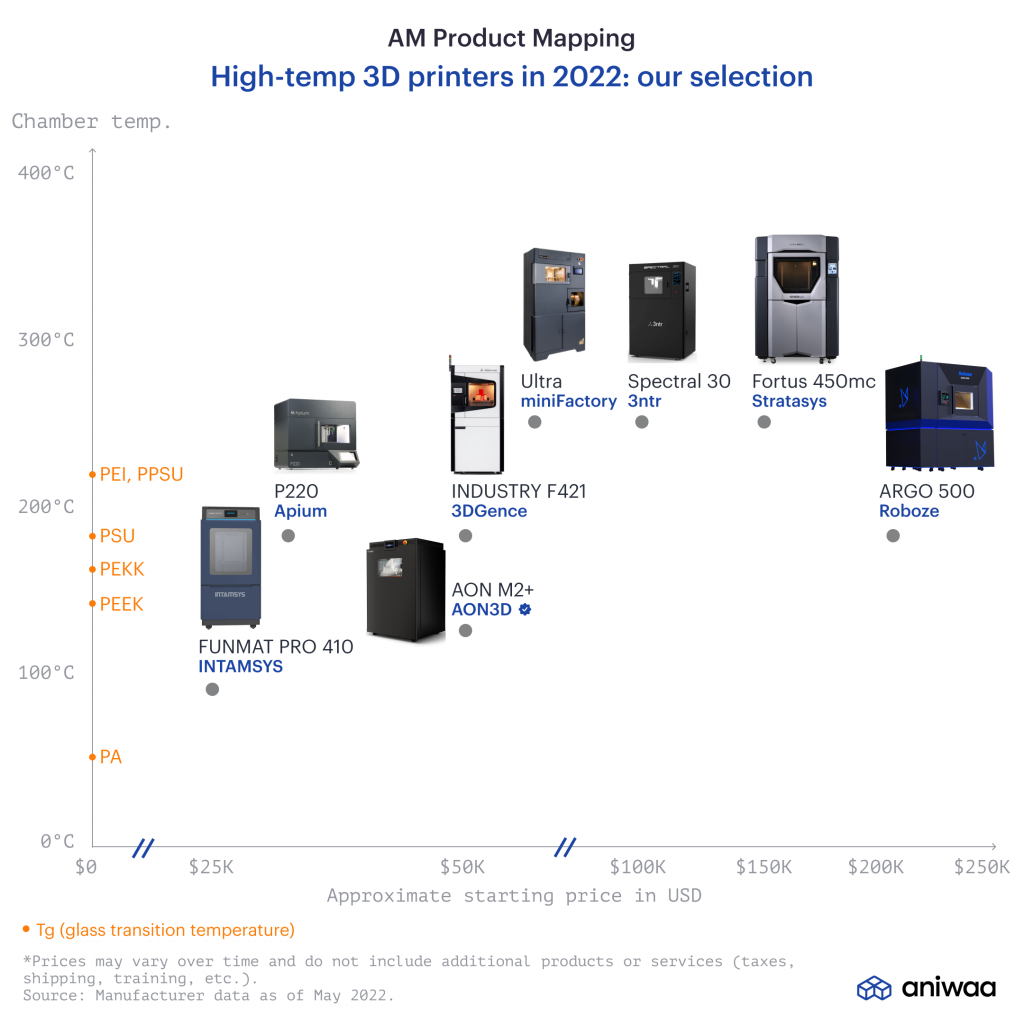
An overview of our 2024 PEEK 3D printer selection
In this section, we give some more context and information about each high-temp 3D printer from our selection.
INTAMSYS has been producing high-temperature 3D printers for several years. The FUNMAT PRO 410 is one of the company’s most affordable solutions along with the FUNMAT HT.
This entry-level solution for high-performance polymer 3D printing features a large build volume, a dual extruder, and sensor-assisted bed leveling.
This German 3D printer provides a smaller build volume than others on our list, but its adaptive heating system is an uncommon characteristic that is essential for compliance with very tight tolerances.
Repeatability is definitely one of the Apium P220’s main advantages, and makes it one of the best PEEK 3D printers on the market.
3DGence’s Industry F420 is an enlarged, upgraded version of the Industry F340, a 3D printer for PEEK that we’ve featured before.
It boasts even higher temperatures, as well as a new filament chamber that can hold up to four spools and keep them heated at 50°C.
Paired with miniFactory’s AARNI process monitoring system, the Ultra is able to deliver certifiable 3D printed parts.
It’s equipped with an annealing system as well, making it possible to enhance part quality and dimensional stability. The printer’s heated filament chamber keeps materials prepped at 120°C.
Italian manufacturer 3ntr has been producing high-temperature 3D printers for several years, but the Spectral 30 is their first printer to be officially dedicated to PEEK and PEI.
With its quadruple 500°C extruders, 300°C build plate, 250°C build chamber, and 110°C filament bay, the Spectral 30 is hard to match. This 3D printer also features a door safety feature: the door is locked until the temperature has descended to 55°C.
Stratasys produces some of the best professional and industrial printers on the market. While their systems used to be limited to Stratasys-branded materials, they’re now (H2 2022) compatible with Stratasys-validated materials from other brands. Materials that have not been validated by Stratasys can also be used, but with an annual Open Material License subscription.
The material choice for the Fortus 450mc includes ULTEM 1010 and ULTEM 9085, and a range of ABS, PC, ST, PEKK and PA-based filaments. Stratasys markets the Fortus 450mc as a reliable machine that doesn’t require particular skills or advanced knowledge of 3D printing.
The INTAMSYS FUNMAT PRO 610HT is a large volume PEEK 3D printer made by INTAMSYS, a manufacturer based in China. The company has a global network of resellers and regional offices located in Stuttgart, Germany and Minneapolis, MN, United States.
INTAMSYS specializes in developing high-temperature 3D printers meant to 3D print with high-performance materials. Such materials include, for example, PEEK, PEI (ULTEM), and PEKK. The FUNMAT PRO 610HT is also compatible with composite materials, including carbon fiber and glass-filled filaments. INTAMSYS 3D printers are all open material systems either welcoming INTAM™ filaments (which come with ready-to-print settings) or filaments from third-party manufacturers.
This type of 3D printer is destined for use where strong, resistant, and lightweight prototypes or end-use parts are required.
The Roboze ARGO 500 is an industrial-grade solution from Roboze, an Italian manufacturer that has dedicated itself to the high-temp 3D printer sector since 2014. The ARGO 500 sits at the middle of the company’s ARGO production series, in between the smaller ARGO 350 and larger ARGO 1000.
Roboze’s high-temperature 3D printer controls, analyzes and stores all of the information and parameters from each print in its onboard, industrial B&R computer. This means that each part can be certified.
There are a few other brands that produce good quality PEEK and PEI printers, which almost made it to the main list. However, we didn’t include them for different reasons (e.g. product not yet released, limited distribution network, and/or technical specs or features not up to par with the rest of the list, etc.).
Tip: Use our 3D printer catalog to see the full list of high-performance polymer 3D printers!
Alternative PEEK 3D printers for specific needs
While the high-temperature 3D printers from our selection are excellent options for most applications, some use cases require more specific solutions. Here are a few examples.
Medical PEEK 3D printing
PEEK is a great contender for medical applications. It is namely used for long-term medical implants, as medical-grade PEEK is biocompatible and highly resistant. With certified materials and certified AM systems, it is possible to produce certified medical parts.
Another notable benefit is that PEEK implants, in contrast to metal implants, don’t interfere with scanning machines (MRI, CT, x-rays, …).
The three main medical PEEK 3D printer brands are Apium, VeraShape, and Kumovis.
Cost-effective PEEK printers
If you have a smaller budget but you’re willing to spend more time on tweaking and adjusting, there are more affordable options out there such as:
Affordable PEEK printer prices can start from around $5,000. They are able to print PEEK, but the resulting quality may not meet your standards, especially in terms of repeatability. These machines are however more than capable of printing other engineering-grade materials.
Custom PEEK 3D printers
Some brands like Tobeca, Qualup (SpiderBot), or Hyrel 3D aren’t widespread but offer interesting, tailored solutions for PEEK 3D printing.
Their custom PEI/PEEK 3D printers can be suitable for R&D applications or any case where specific sizes and components are needed.
Large, industrial PEEK 3D printing systems
Warpage is often an issue when 3D printing large parts. Hence, 3D printing large parts with a thermoplastic as challenging as PEEK is double the risk.
Some manufacturers that are specialized in large-scale 3D printers claim that they are also able to print PEEK (e.g. Cincinnati, BigRep, CEAD, Cosine Additive, etc.).
We know the PEEK printer market like the back of our hands. Contact us now to save time and receive expert advice based on your needs and budget. We’ll put you in touch with the right manufacturer or PEEK 3D printer distributor near you.
Key characteristics and properties of PEEK
Pros of PEEK filament
PEEK is a dimensionally stable, semi-crystalline thermoplastic. It can tolerate significant changes in temperature, humidity, and other conditions.
Here are some of the main benefits of PEEK:
- Useful operating temperature (a.k.a. continuous use temperature) of up to 250°C-260°C
- Low flammability and low levels of toxic emissions during combustion
- High mechanical strength
- Low moisture absorption; water and steam resistant
- Chemical resistance (with exceptions)
- Biocompatible
- Lightweight
PEEK drawbacks
This material also has a few limits:
- Complex to 3D print
- PEEK is expensive
- Low impact strength
- Non-resistant to UV light
Alternative high-performance materials
PEEK isn’t the ultimate “one size fits all” material. In many cases, other engineering materials or fiber-filled materials (composites) can substitute the need for PEEK. Here are a few examples.
PEKK (Poly Ether Ketone Ketone): a good alternative to PEEK
PEKK and PEEK are both part of the same polymer family called PAEK (Poly Aryl Ether Ketone). They boast similar properties in terms of strength, chemical resistance, and more. However, PEKK can be easier to 3D print than PEEK.
It is possible for filament manufacturers to tweak its melting point, and therefore generally requires lower temperatures. PEKK can also have a slightly higher glass transition temperature (Tg) than PEEK.
PEEK vs. ULTEM (PEI)
PEEK and ULTEM® (PEI) are quite similar, but have their differences:
- Cost: ULTEM® is more cost-effective than PEEK.
- Impact strength: PEI has lower impact strength than PEEK.
- Tensile strength: PEEK has higher tensile strength than PEI.
- Certifications: ULTEM® (especially the ULTEM® 9085 blend) has received numerous aerospace certifications and is easier to 3D print.
- Temperature resistance: PEEK features higher temperature resistance than PEI.
- Printability: ULTEM® is generally easier to 3D print than PEEK is.

What’s the difference between PEI and ULTEM?
ULTEM® is actually a family of PEI products that was patented and developed at General Electric in the 1980s. SABIC, a company based in Saudi Arabia, acquired GE’s Plastics Division several decades later and now manufactures ULTEM® in the form of resins or foam. 3D printing material providers then transform it into granulates, filament, etc.
Continuous fiber reinforcement
It is also possible to reinforce PEEK or PEKK parts with a continuous strand of carbon fiber. This makes it possible to benefit from high-performance material properties (e.g. chemical resistance) while bringing a drastic increase in part strength.

Chopped fiber reinforcement (“filled” materials)
There are a number of “filled” material options. A filled material is a material that has been reinforced with, for example, chopped fibers such as carbon fiber or glass fiber. These materials are considered composites and can be good alternatives in some cases (learn more about composites here).
Common examples of filled materials include PEEK-CF (a carbon-fiber-enforced PEEK) and PA-CF (carbon-fiber-enforced Nylon).
Main requirements for 3D printing PEEK and PEI high-performance polymers
High-temperature extruder
The melting point for PEEK materials is 343°C. This means that the extruder needs to be able to reach that temperature or higher. The hotend extruder must also be all-metal and be resistant to abrasion.
Heated print bed
To print PAEK high-performance polymers, a heated bed is mandatory, and it must be able to reach temperatures of 120°C at the very least. This ensures correct adhesion and overall 3D print quality.
Closed, heated chamber
PEEK is highly prone to shrinkage and warpage (sometimes called warping). Ideally (and this is especially important for larger parts), the chamber temperature should be able to go up to or over 143°C, which is PEEK’s glass transition temperature (Tg).
The team at Vision Miner explains heated chambers very well in the video below:
It is extremely important to be in control of these temperatures and to keep them constant, as fluctuations can easily affect print quality. However, these aren’t the only conditions for printing high-quality PEEK parts; post-treatment also plays a major role.
In order for PEEK to crystallize as well as possible – and thus for the printed parts to be as strong and stable as possible – the material must be cooled gradually.
Unlike PLA parts, which can be removed from the tray almost as soon as they are printed, waiting several hours for the temperature of a PEEK or ULTEM part to drop to room temperature is necessary. This avoids disturbing the material’s crystallization process.
Some PEEK printers provide precise control over the chamber’s cooling rate.
You may also like:
Shrinkage, Residual Stress, and Poor Layer Welding in 3D Printing
Applications for high-performance polymer 3D printing
PEEK and ULTEM® 3D printing is mostly useful for manufacturers requiring strong prototypes and/or end parts that can withstand extreme conditions, in a variety of industries.
Some manufacturers even present PEEK 3D printing as an alternative to 3D printing metal parts.
Aerospace, automotive and military
Being lightweight yet strong and resistant, PEEK and ULTEM® 3D printed end parts are increasingly popular in aerospace, automotive and military fields.
ULTEM® has actually been used in the aerospace industry for decades and is heavily certified for related applications (e.g. airplane interiors).
Oil and gas
Thanks to PEEK’s chemical resistance and impermeability, oil and gas manufacturers can use the material to 3D print air valves and other parts.
Medical implants
PEEK and PEI are biocompatible, and can therefore be used for implants or other medical use cases.
Semiconductors
With PEEK’s electrical integrity it is possible to 3D print flexible circuit boards, as well as wire and cable insulation.
Cost of PEEK and ULTEM (PEI) 3D printing
PEEK 3D printers and ULTEM 3D printer prices
Most PEEK-ready 3D printers are available at prices ranging from $25K to $150K, and can even go up to $250K. It might seem like a hefty price tag, but these professional additive manufacturing systems feature specific technology that is difficult to integrate into a machine.
However, some PEEK 3D printers under $10,000 do exist.
PEEK and ULTEM filament price
PEEK filament price
Polyetheretherketone (PEEK) material is among the most expensive plastics on the market: its price can range from about $400 to $700 per kilo.
ULTEM filament price
PEI, or ULTEM®, is a cheaper alternative to high-performance PEEK material. The cost per kilogram can vary from $150 to around $280.
PEEK 3D printer FAQ
ULTEM® is a kind of thermoplastic used for professional and industrial applications.
ULTEM® plastic is Polyetherimide (PEI), a strong, resistant thermoplastic that boasts similar characteristics to PEEK while being easier to 3D print.
Professionals and industrials use PEI to produce strong prototypes or end-use parts.
PEI stands for Polyetherimide and is also known as ULTEM®, which is actually a brand manufactured by SABIC. This engineering thermoplastic is strong and resistant to extreme conditions, though less than PEEK.
PEEK stands for Polyetheretherketone. It is a highly resistant material (extreme temperatures, chemicals, etc.).
 English
English  Français
Français